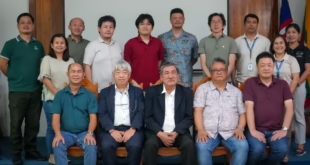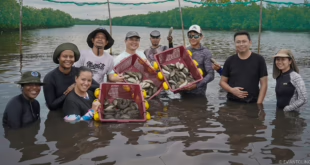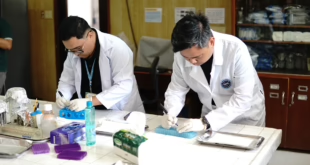By Development Communication Section
In order to disseminate aquaculture information and to further reach out to its stakeholders, a series of lectures on aquaculture technologies developed by SEAFDEC/AQD and other relevant topics on aquaculture were conducted during the Farmers Forum and the Dean Domiciano K. Villaluz Memorial Lecture during SEAFDEC/AQD’s 43rd Anniversary celebration. Likewise, new publications were introduced and distributed in a book launching activity.
Farmers Forum

About 120 guests from the private sector, Philippine government agencies, and the academe attended the Farmers Forum on 14 July 2016 held at SEAFDEC/AQD’s TID Conference Room in Tigbauan, Iloilo, Philippines. There were three lectures by SEAFDEC/AQD experts, namely: Updates on Early Mortality Syndrome (EMS)/Acute Hepatopancreatic Necrosis Disease (AHPND) by Dr. Edgar Amar, Hatchery-produced Single Oyster Spats… the Future of the Oyster Industry! by Ms. Jocelyn Ladja, and The Use of Fertilizers in Seaweed Farming by Ms. Maria Rovilla Luhan. Mr. Roy Ortega, OIC of the Inland Fisheries and Aquaculture Division of the Bureau of Fisheries and Aquatic Resources (IFAD-BFAR), also gave a talk on Climate Resilient Aquaculture Operations Guide for Region 6 (June-December 2016).
For the first lecture, Dr. Amar discussed that EMS/AHPND is a disease affecting shrimp caused by strains of Vibrio parahaemolyticus. This disease destroys the hepatopancreas of shrimp resulting in early mortality, about 35 days or less, after stocking in grow-out ponds. Gross signs of shrimp with EMS/AHPND are an empty stomach, atrophied and pale hepatopancreas, and empty midgut. Some preventive measures to avoid AHPND include: (1) improving pond cleaning and disinfection measures, (2) controlling stocking density, (3) avoiding residual feed, (4) maintaining good quality of water and pond bottom, (5) adding probiotics in feed, and (6) polyculture with tilapia or mullets.
On the second lecture, Ms.Ladja talked about the production of oyster spats in the hatchery. She presented that production of spats in the hatchery can be done anytime and yields good quality single oysters. Ms. Ladja also discussed the procedure in producing oyster spats in the hatchery as well as nursery and grow-out culture in ponds.
Next, Ms. Luhan shared the importance of enrichment or the use of fertilizers in seaweed farming. A fertilizer, as discussed by Ms. Luhan, is any material of natural or synthetic origin applied to soil or plant tissues to supply plant nutrients essential to its growth. Macro nutrients vital for the growth of seaweeds are nitrogen, phosphorus, and potassium. Some compounds like Calcium Peroxide are also added sometimes. Farming of the seaweed Kappaphycus alvarezii is faced with problems such as occurrence of ice-ice disease and deterioration of growth. However, these problems were addressed by the study on seaweed enrichment conducted by Ms. Luhan and her team. Their study shows that seaweed enrichment increased the growth rate, reduced the occurrence of ice-ice disease and carrageenan quality remained good.
Lastly, Mr. Ortega shared what actions fish farmers can take during a change in climate. He discussed first the climate typology of Region 6 and the weather systems (e.g. Southwest monsoon, transition towards Northeast monsoon, tropical cyclones, low pressure areas, thunderstorms, etc.) that may affect the Philippines from June to November 2016. He also talked about the immediate impact of weather systems on the aquatic habitat and aquaculture operations. Mr. Ortega also presented adaptive response guidelines for short to medium term weather events applicable to culture operations of various commodities. Finally, he shared some aquaculture emergency preparedness guidelines for the different weather systems.
Aside from the lectures, a demonstration on sex-reversal of tilapia was also conducted by SEAFDEC/AQD technical assistant Mr. Mark Neil Samoranos.
The guests also had the opportunity to tour SEAFDEC/AQD facilities at its Tigbauan Main Station in Iloilo, Philippines.



Dean Domiciano K. Villaluz Memorial Lecture

SEAFDEC/AQD scientist Dr. Mae Catacutan was this year’s speaker for the 24th Dean Domiciano K. Villaluz (DKV) Memorial Lecture held 15 July 2016 at SEAFDEC/AQD’s TID Conference in Tigbauan, Iloilo, Philippines.
More than 100 guests, mostly from the academe, were present to listen to Dr. Catacutan’s talk on Alternative feed ingredients as substitutes for marine sources of protein and lipid for important aquaculture species.
Here is an excerpt of Dr. Catacutan’s lecture:
Over the years, fish production from aquaculture has been rapidly growing. This is largely due to good management and adequate aquaculture feed.
About 60% of the production cost in aquaculture goes to feed. The major component of aquaculture feed are fish meal (FM) and fish oil (FO) typically of marine origin. The aquaculture industry’s demand for continuous supply of good quality feed ingredients of marine origin has put pressure on wild fisheries. Thus, alternative feed ingredients as substitute for FM and FO were identified and developed.
Replacement of FM and FO is recognized as an international research priority in order to achieve a sustainable increase in aquaculture production. Research results showed that inclusion levels of FM and FO of marine origin can be reduced to corresponding recommended levels for carnivorous, omnivorous and herbivorous fish without affecting growth performances. Alternative sources include feed ingredients of plant origin, by-products of the food processing industry, and non-traditional feed ingredients.
Some suggestions to increase utilization of alternative ingredients are:
- information on amino acid composition and digestibility of plant protein sources for target species must be available,
- nutritional value of plant feedstuff should be improved to increase use in feeds for carnivores,
- processing cost in increasing crude protein levels in plant-derived products must be decreased,
- monitor effects of plant ingredients on product quality and consumer health, and
- increase feed intake by increasing palatability through characterization of taste elements of plant feedstuff.
The current trends in the aquaculture industry to ease the use of marine FM and FO in aquaculture feed are the following:
- FM and FO are used more in the early stage of fish growth since less amount of feed is needed,
- genetic manipulations of plants for specific traits like more oil production from seeds,
- consumption of fish species with low protein requirement are promoted (i.e. in Malaysia), and
- sharing of information among ASEAN member states on feed ingredients with potential as substitutes for FM and FO.
Book Launching

In line with this year’s DKV Memorial Lecture topic, one of the new publications introduced during a book launching activity was the proceedings of the ASEAN Regional Technical Consultation on Development and Use of Alternative Dietary Ingredients or Fish Meal Substitutes in Aquaculture Feed Formulation. Other publications launched during the event were a milkfish seed production manual, abalone life cycle poster, and giant freshwater prawn & grouper culture flyers.
Open-access publications, which can now be accessed at https://repository.seafdec.org.ph/, were also introduced to the guests. These are proceedings of workshops or regional technical consultations on mangrove-friendly aquaculture, responsible aquaculture development in Southeast Asia, and stock enhancement for threatened species of international concern.
The launching of the IAMSLIC Digital Fisheries Library with SEAFDEC/AQD publications capped the book launching activity.

 SEAFDEC/AQD Southeast Asian Fisheries Development Center | Aquaculture Department
SEAFDEC/AQD Southeast Asian Fisheries Development Center | Aquaculture Department



